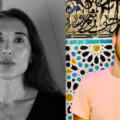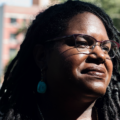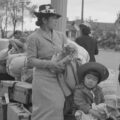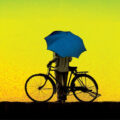Tina Chow’s Articulate Silence

Tina Chow’s Kyoto and Saturn bracelets
I was exuberant when I first imagined writing this essay. I have been obsessed with Tina Chow for years. When asked why, I was never able to pinpoint the reason. What exactly was it about Chow, or her life, that drew me to her? It was something ephemeral, inexplicable. A quality perhaps not unlike the one Chow possessed—that something between words, visceral—that drew people to her.
I knew that very little has been written about Chow’s life and work. Aside from one article by Michael Gross in New York Magazine, I had not been able to find anything of substance. Lots of blog posts by admirers and references to Chow by designers and other celebrities. Even here, in these flashes, she remains enigmatic, something memorable and, in fact life changing, that occurs but then vanishes. The more time I spent collecting data on her upbringing, career, marriage, and other statistics, the more I recognized that even these solid and substantial facts did not speak to the essence.
The one book “about” Tina Chow is titled Flair: Fashion Collected by Tina Chow. The text is a photographic compendium of items from Chow’s Couture collection. Essentially the catalogue for an exhibit of Chow’s collection held at the Fashion Institute of Technology in March of 1992, the book has become something of a fetish, a relic, for Chow fans. Aside from Flair and the New York Magazine article, there are no texts or articles, or at least nothing I could find using library catalogues and online searches. Instead, what one finds is a proliferation of images: Chow modeling, Chow at her husband‘s downtown restaurant, entertaining guest celebrities; Chow posing over and over.
In every image Chow appears beautiful, perfectly presented, glowing, in fact, regardless of where on the compendium of time the images occur: during her marriage to Chow when she was staying up all night, drinking with celebrities, later when she left him and began studying Tibetan Buddhism and holistic healing methods, or even later, ill with AIDS—in all of the photographs, she radiates.

Andy Warhol’s portrait of Tina Chow
That there is a seemingly endless proliferation of photographs of Chow and yet very little writing about her or even from her could, in itself, be considered a way to “read” Chow. Like other female artists who refused to provide context to their life or their life’s work, one is then forced to read that artist’s life through their work but also, in the case of Tina Chow, her performance and presence in the endless steam of images. One might eschew such reading, suggesting that Chow, as a style icon, was simply photographed for her beauty and appearance, the very fact of her being a style icon suggests that she was communicating through her appearance.
In other words, she was performing her experience of the world through the persona she presented in her photographs. And in this way Chow was creating a language of her own—a means to speak to the viewer, to us, through her performance of the persona, Tina Chow. Chow was born not as Tina Chow, but as Bettina Louise Lutz. And this persona, or mask, provided Chow (or Lutz) with a means to communicate the in-between, the space without language. When she realized this mask or persona was more a hindrance than a means through which she might communicate, this is the moment when she left her husband and began to become who she really was.
What language is this, then, this endless stream of images without words, or, rather, with very little text, this parade of images inside the silence that occurs without words? What this is, actually, is the beginning of a possible means, a language in fact, to speak about Tina Chow and her life—this lack of words and the profusion of images—speaks precisely to her life.
Tina and Michael Chow were divorced in November of 1989. She was diagnosed with AIDS in June of 1989. She died in January of 1992. She turned, while she still with her husband, from the social world they lived in and devoted herself to AIDS charity work. She broke from her old life before she was diagnosed and committed herself to the creation of art, to the redemption of overlooked materials and objects. It’s as though she knew. She was working with a finite amount of energy and time; she needed to make a drastic change, so that she could finally live.
Tina Chow was born Bettina Louise Lutz in Lakeview, Ohio, in 1950. Walter Edmund Lutz, her father, met her mother, Mona Furuki, while he stationed in Occupied Japan during World War II. After the war, the couple moved to Cleveland, Ohio, where her father opened up a shop called the Bamboo House. Of her childhood in the United States, Chow said:
It was the fifties and the early sixties and people believed in everything. They believed that god did bless America. The only problem was that I wasn’t all-American, and there was no alternative to being all-American. Everyone was a cheerleader or aspired to be one… I never went on a date, was never asked out, was never asked to dance.
In 1966 the family moved back to Japan to set up an import-export business, and Tina and her sister, Bonny, finished school there. Tina explained:
It was like going back to where we belonged, Tina said, “seersucker kimonos … paper balls and lanterns and firecrackers … frogs and crickets for sale in cages and rock candies that were shocking pink, green, and white…”
When she was just a few months old, Tina and her sister appeared in the film “I Was a Japanese War Bride,” based on the story of her father and mother. In 1968, in Japan, Tina and her sister were discovered by the Japanese cosmetics company, Shisedio, and their mother became their manager. “They were very aware that I came from a very good family the minute my mother opened her mouth, and that’s what they were looking for,” Tina explained. “True, I was a half-breed, but they were also going in for that. They liked the Eurasian look”
The way Chow speaks of her experiences is telling: though she is aware of how fortunate she has been, she is quick to note the other, darker, side: first, with regard to her experiences in the United States and then with her experience of being discovered by Shisedio.
There are endless possible interpretations of why and how she came to these, but what I found most interesting is how she presents both: the good and the bad, and taking neither. Instead, it’s as if she dissolves between them.
She embodies this in-between, an essence or language unlike anything or anyone before her, neither Japanese nor German, not fully American, not female nor male. And how does one speak of or about this ephemeral quality? How does one describe something or someone unknown otherwise? If I say Chow was Japanese or German, the reader receives a notion, an idea or image, carried within the word that signifies. Japanese. German. But these very signifiers, the very words and the myriad of meanings implicit within them, cannot speak to who she is or was.
The words I would use to help paint a portrait of who and what Tina Chow was or is serve only to confine her, to trap her, within those limiting prisms.

Helmet Newton’s portrait of the Chows
In 1985 Helmut Newton took a portrait photograph of the couple in which their power dynamics are made evident: in the photograph, the two are separated, physically, by the counter of a bar: he standing in dark glasses, holding a glass in his hand, staring at her while she is on the other side, in a long white dress, her eyes made dark with make-up, tied to the bar with rope.
Over the years, Chow had befriended Andy Warhol, who was a regular at their restaurant, and Warhol encouraged her to explore creative outlets. In a Vanity Fair essay, “Ciao Tina,” Maureen Orth writes:
One day Warhol showed Tina two crystal pendants he’d been wearing, and told her they had powerful healing properties. From then on she was hooked on beautiful rocks, and they went with her everywhere. After a proposal to work on an accessory line with the famed French bead embroiderer Lcsage fell through in 1986, she decided to design jewelry using crystals. “she wanted people to be beamed up without even knowing it.” says Ann Moss, who is married to Jerry Moss and also collects crystals. Michael Chow was not pleased: “She has the jewelry, I had nothing.”
After seventeen years of marriage, Chow left her husband. She had performed the role of the obedient wife, the hostess of their restaurant, living inside a non-stop party, and then fled these worlds by moving away from the scene at which she and her husband had been, for many years, the center.
“No one can live on Kir Riyals and espresso,” the photographer David Seidler remarked. “I remember it making her sick. It got to her. She realized that.” In an article in the Chicago Tribune, Chow explained, “I lost several friends to AIDS and I felt my life slipping away while I continued to party.” Marie Brenner describes Chow when she first met her, in her early years of marriage, “She was a very innocent, very fragile girl moving through these beautiful rooms explaining every piece of furniture, and I’m thinking, There is something about putting this girl in this atmosphere that will ultimately do her in.”
She wanted, finally, to explore who she was. Another driver was the AIDS crisis, which had, by now, taken so many of Chow’s friends. She threw herself into AIDS charity work, focusing on meditation and other forms of holistic healing. She embarked on a series of affairs, first with the actor Richard Gere, who introduced her to Tibetan Buddhism and the Dalai Lama, later with the French aristocrat Kim D’Estainvillle. In 1989, Chow learned that she had contacted HIV from D’Estainville. This prompted even more changes in her life. Tina’s sister, Bonnie, says, “She was longing to express her own talent—she’d never had something that was just her own oeuvre. A spiritual search was beginning. The old was breaking up for the new. It was kind of like a bird molting.”
After leaving that life, Chow began to make her own art with her own hands. She crafted jewelry using rock crystal, gold, silver, wood, bamboo, and silk cording. Chow’s pieces of jewelry are unusual, neither delicate or what one might usually consider “beautiful.” Instead, the pieces are solid, anchored. The piece Chow for which is best known is her Kyoto Bracelet. The bracelet, constructed of black bamboo, has seven rose quartz pebbles inside it. What makes this work different from other women’s bracelets is first of course its incredible beauty, but also its unconventionality: the use of black bamboo as well as the structure of the piece, which is solid and, in fact, quite masculine. This contrast speaks to Chow’s complicated life and identity: neither Western nor Eastern, neither masculine more feminine. And finally, the inclusion of the seven quartz pebbles inside the bracelet—rather than the expected display of jewels on the outside of the piece—articulates to Chow’s own values and beliefs.
Chow had begun designing jewelry in the mid 1980s, after Warhol introduced her to crystals and continued to encourage her work. She wanted to include the crystals in the work so that whoever wore the jewelry would be healed, without knowing the creator’s intention. Warhol had, in a sense, healed her by introducing her to the crystals but also through his ability to recognize her underneath the facade. Warhol saw Chow and this seeing reinforced her own agency. This power, this invisible healing, is what Chow wanted to give others, through her art.

Tina Chow’s crystal bracelet
She traveled around the world to find the perfect materials. In Japan she worked with the artist Kosuge Shochikudo, who created baskets used in tea ceremonies. By integrating her Japanese heritage while infusing materials used for ritual, Chow was performing a type of alchemy, the melding of disparate elements to create one that was entirely new, not unlike her own experience of being Japanese and German and yet, in a sense, being neither—or, rather, of being neither, but also being something entirely new.
In 1987 Chow’s first collection was shown at Bergdorf Goodman in New York, Maxfield’s in Los Angeles, Ultimo in Chicago, and at Gallerie Naila Monbrison in Paris. That same year she moved into the Chateau Marmont Hotel in Los Angeles.
The idea of healing was of paramount importance even before she learned her body carried the HIV virus. Her desire for healing and self-cleansing, perhaps, arose from a need to rid herself of her previous life, a life in which she live according to the beliefs of others. “Tina hired a young assistant, Grayson Riley,” Michael Gross writes, “and would send her downtown to Kiehl’s pharmacy to buy herbs and brushes that she used to scour her skin red. That struck Riley as symbolic of Chow’s attempt to remove all the toxins from her life.”
Before she even became sick, Chow had already attempted to heal herself with crystals, macrobiotics, teas, and similar somatic modes of healing. When she was diagnosed with AIDS, Chow refused to take any of the medicine her Western doctors recommended. Instead, she opted for a holistic approach. She believed she could transform herself, alchemically, into something cleaner, more pure, more essential. Chow’s design work—using her own hands to create something—was a form of mastery, an act in which, after years as a supporting character, she was the creator. In her previous life she has been sculpted, made into a perfect and beautiful work of art; by the end of her marriage, the desire to be the maker had manifested, finally, in her jewelry. Orth writes:
In battling AIDS, she recreated herself, from passive to aggressive from enabler to achiever. She retreated totally from her earlier, gilded life in London and New York to the rugged California coastline, and in the last year she began to sculpt in wood. According to Bonny (her sister), the act of creation was the one thing “that transformed and enlivened her.”
I kept thinking of the word haptic while writing and looking at the life of Tina Chow, her work and the seismic change that occurred to her or, rather, that she manifested, seventeen years into her marriage. Haptic is derived from the Greek haptikos, which means “pertaining to the sense of touch” and “able to come into contact with,” from haptein which means “to fasten.” It is the sense of touch, of texture and making aesthetic choices based on a holistic approach, rather than a purely aesthetic (disinterested) one. How the material feels on the skin, what the texture of the piece feels like in the hand, and how remnant and fragment become introduced and then absorbed into the work: this word and its myriad meanings makes sense of Tina Chow.
The act of making and, in particular, the act of making from nothing and/or from remnants or from scrap—items perhaps considered useless—is a phenomenal act of transformation. By using remnants as the centerpiece of a work is to invert the meaning of those objects. Chow’s inclusion of bamboo both transforms the bamboo from an invasive overgrowth into a prized possession while questioning the very idea of what it means to be Japanese. In a sense, Chow created a new vernacular in the creation of these pieces—which, in the end, speak on her behalf. This speechless language stands in relief against the paucity of writing about Tina Chow, despite the proliferation of images in which she appears beautiful and, even in the photos taken toward the end of her life, graceful and, yes, perfect. Against these images, another means of “reading” Chow is through her own work—handwork infused with her struggles, with her desire to harness her troubles and challenges and transform this into a healing power.
About Cynthia Cruz
Cynthia Cruz is the author of Wunderkammer (Four Way Books, 2014), The Glimmering Room (Four Way Books, 2012), and Ruin (Alice James, 2006). She has published poems in The New Yorker, Kenyon Review, The Paris Review, the Boston Review, and elsewhere.





